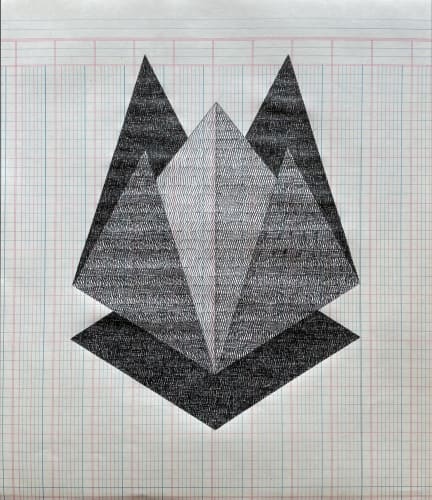Etherton Gallery presents Albert Chamillard: Hyena, an exhibition of pen and ink drawings made by one of Tucson’s most forward-thinking and inventive artists. Chamillard makes crosshatch drawings that combine calligraphic precision and expressiveness of line with the meditative process of mark-making. Accompanying Chamillard’s drawings will be a selection of vintage photogravures by influential German photographer, Karl Blossfeldt (1865-1932). An artist reception will be held Saturday, December 10, 7:00PM-10:00PM with live music on the patio provided by the Jed Paradies Trio.
“I’m proud to present Albert Chamillard’s drawings to the city of Tucson,” said Terry Etherton, owner of Etherton Gallery. “Albert belongs to a new generation of Tucson artists making brilliant, epoch-making work.”
The Hyena is a metaphor for the artist taken from American writer Henry Miller’s semi-autobiographical novel, Tropic of Cancer, published in 1934 but banned in the United States until 1961. “The dawn is breaking on a new world, a jungle world in which lean spirits roam with sharp claws. If am a hyena I am a lean and hungry one: I go forth to fatten myself.”
Most of the drawings featured in Hyena were made at a difficult time in Chamillard’s life. They took shape during his daily drawing practice, which evolved into a kind of daily, graphic affirmation of life. The Hyena drawings were all made using vintage ledgers found at yard sales or thrift stores, or plain cotton fiber paper, and commercially available Pilot G2 pens. In his use of these materials, Chamillard explores the formal challenges of making refined art objects in a medium traditionally seen as the dress rehearsal for painting, and the possibilities it affords for deeply personal expression.
The Hyena drawings present simple geometric forms that disguise multiple, sometimes conflicting ideas in a single work. Atypical Hyena (2022), which brims with allusions to violence and sexuality, comprises thousands of tiny lines that form geometric patterns across a field of pink and blue grids in a collision of personal narrative, lo-fi materials, and gesture, splashed across the page. Slow Explosion(2022), sets up a simmering emotional tension between the intense amount of work its creation demands and an implied impatience with time. Although the rigorous framework of Chamillard’s drawings recalls the ideas of Conceptualism, he also embraces linear irregularities for their connection to the artist’s hand.
Chamillard’s drawings strike a much-needed optimistic note, offering us a direct and visceral response to the world in a moment of collective uncertainty.
“I’m proud to present Albert Chamillard’s drawings to the city of Tucson,” said Terry Etherton, owner of Etherton Gallery. “Albert belongs to a new generation of Tucson artists making brilliant, epoch-making work.”
The Hyena is a metaphor for the artist taken from American writer Henry Miller’s semi-autobiographical novel, Tropic of Cancer, published in 1934 but banned in the United States until 1961. “The dawn is breaking on a new world, a jungle world in which lean spirits roam with sharp claws. If am a hyena I am a lean and hungry one: I go forth to fatten myself.”
Most of the drawings featured in Hyena were made at a difficult time in Chamillard’s life. They took shape during his daily drawing practice, which evolved into a kind of daily, graphic affirmation of life. The Hyena drawings were all made using vintage ledgers found at yard sales or thrift stores, or plain cotton fiber paper, and commercially available Pilot G2 pens. In his use of these materials, Chamillard explores the formal challenges of making refined art objects in a medium traditionally seen as the dress rehearsal for painting, and the possibilities it affords for deeply personal expression.
The Hyena drawings present simple geometric forms that disguise multiple, sometimes conflicting ideas in a single work. Atypical Hyena (2022), which brims with allusions to violence and sexuality, comprises thousands of tiny lines that form geometric patterns across a field of pink and blue grids in a collision of personal narrative, lo-fi materials, and gesture, splashed across the page. Slow Explosion(2022), sets up a simmering emotional tension between the intense amount of work its creation demands and an implied impatience with time. Although the rigorous framework of Chamillard’s drawings recalls the ideas of Conceptualism, he also embraces linear irregularities for their connection to the artist’s hand.
Chamillard’s drawings strike a much-needed optimistic note, offering us a direct and visceral response to the world in a moment of collective uncertainty.

